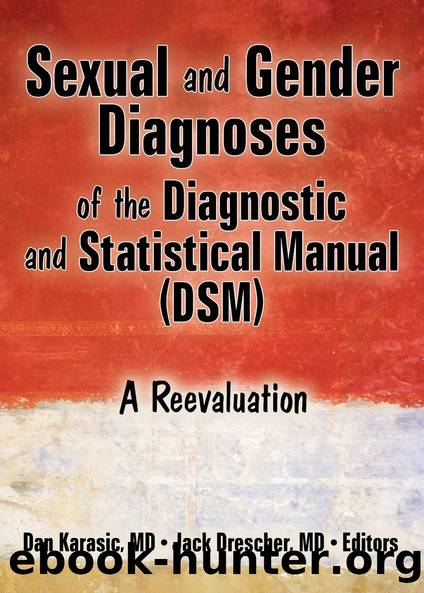Sexual and Gender Diagnoses of the Diagnostic and Statistical Manual (DSM) by Dan Karasic Jack Drescher

Author:Dan Karasic, Jack Drescher [Dan Karasic, Jack Drescher]
Language: eng
Format: epub
ISBN: 9781317954569
Barnesnoble:
Publisher: Taylor & Francis
Published: 2014-05-01T00:00:00+00:00
Gender Identity Disorder in the DSM
Gender identity disorders first appeared as a subclass in the class of Psychosexual Disorders in the DSM-III (APA 1980, p. 261). They included two diagnostic categories, Transsexualism, 301.5x, a term coined by Magnus Hirschfeld (1923), and Gender Identity Disorder of Childhood, 302.6. Transsexualism was defined by a persistent sense of discomfort and inappropriateness about oneâs anatomic sex and a persistent wish to be rid of oneâs genitals and to live as a member of the opposite sex for a period of at least two years (p. 263). A separate childhood category, with onset before puberty, was characterized by a strong and persistent stated desire to be or insistence that one is of the other sex and for natal males by nonconformity to male behavioral stereotypes (p. 265).
In DSM revision III-R (APA 1987), Gender Identity Disorders were moved to the class of Disorders Usually First Evident in Infancy, Childhood or Adolescence (p. 71), recognizing that âsymptomsâ of transsexuality almost always begin in childhood (p. 424). The diagnostic criteria for GID of Childhood, 302.60, were broadened to include gender role nonconformity for natal girls: âpersistent marked aversion to normative feminine clothing and insistence on wearing stereotypical masculine clothing . . . â (p.73). While issues of diagnosis of gender variant children are beyond the scope of this article, this change illustrated an increased emphasis on social nonconformity in the diagnostic criteria that continued through the DSM-IV and IV-TR. Most important, Gender Identity Disorders in the DSM-III were expanded to implicate a wide range of gender variant individuals with a new category, Gender Identity Disorder of Adolescence or Adulthood, Nontranssexual Type (GIDAANT), 302.85 (p. 76). GIDAANT was defined by persistent or recurrent discomfort about oneâs assigned sex and cross-dressing in the role of the other sex, either in fantasy or actuality (p. 77). The diagnostic criteria excluded transsexual individuals wishing to be rid of their born sex characteristics and cross-dressers where sexual excitement was presumed the motivation. The latter were diagnosed with Transvestic Fetishism, 302.30, which remained in the DSM in the Paraphilias subclass of Sexual Disorders (p. 288). Transgender individuals who were not transsexual or distressed by their genitalia, however comfortable and well adjusted in a cross-sex role full time or part time, became diagnosable as mentally disordered in the DSM-III-R. By an unintended oversight in the diagnostic criteria, gender dysphoric subjects thought to be aroused by cross-dressing were precluded from diagnosis of Transsexualism, GIDAANT or Transvestic Fetishism, leading to an excessive number of cases classified as Gender Identity Disorder Not Otherwise Specified (GIDNOS) (Bradley et al. 1991).
In the DSM-IV (APA 1994), Gender Identity Disorders were returned to the class of sexual disorders, which was renamed Sexual and Gender Identity Disorders (p. 493). The DSM-III categories of Transsexualism, Gender Identity Disorder of Childhood and GIDAANT were subsumed by an expanded category, Gender Identity Disorder (GID), coded 302.85 for adults and adolescents and 302.6 for children (p. 538). The diagnostic criteria for adults are listed in Table 1.
Unlike
Download
This site does not store any files on its server. We only index and link to content provided by other sites. Please contact the content providers to delete copyright contents if any and email us, we'll remove relevant links or contents immediately.
Human Diseases (MindTap Course List) (by Team-IRA) by Marianne Neighbors Ruth Tannehill-Jones(844)
The Neglected Dimension of Global Security: A Framework to Counter Infectious Disease Crises by National Academy of Medicine Secretariat(421)
Statistical Methods in Health Disparity Research by J. Sunil Rao(399)
Imaging in Urology by Mitchell Tublin MD Joel B Nelson MD(394)
Short Course in Medical Terminology by Nath Judi L.;(331)
Cancer Cell Culture by Unknown(310)
Wilkins' Clinical Practice of the Dental Hygienist by Boyd Linda D.;Mallonee Lisa F.; & Lisa F. Mallonee(301)
Clinical Research in Occupational Therapy, Sixth Edition by Martin Rice;(300)
Murray's Basic Medical Microbiology E-Book by Murray Patrick R.;(282)
Anatomical Kinesiology by Gross Michael;(281)
Psychedelics As Psychiatric Medications by Nutt David;Castle David;(272)
Neuroscience Fundamentals for Rehabilitation by Lundy-Ekman Laurie(271)
Health Behavior: Theory, Research, and Practice by Karen Glanz & Barbara K. Rimer & K. Viswanath(271)
Rang & Dale's Pharmacology 9th Edition plus Flashcards 2nd Edition by Unknown(250)
Achieving Procreation : Childlessness and IVF in Turkey by Merve Demircioğlu Göknar(249)
Public Health and Society: Current Issues by Burke Lillian D.;Weill Barbara;(246)
The Handbook of Medicinal Chemistry by Simon E Ward;Andrew Davis;(245)
Primary Care Occupational Therapy by Unknown(239)
From Good Schools to Great Schools by Susan P. Gray & William A. Streshly(232)
